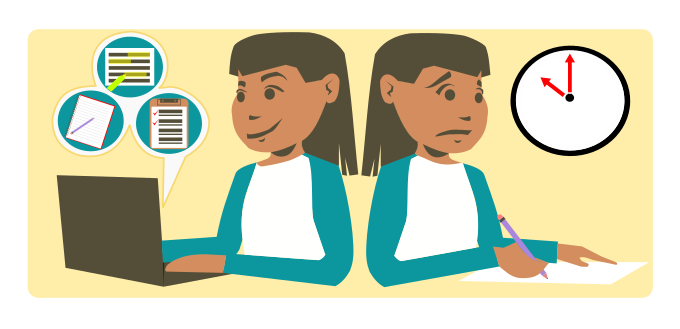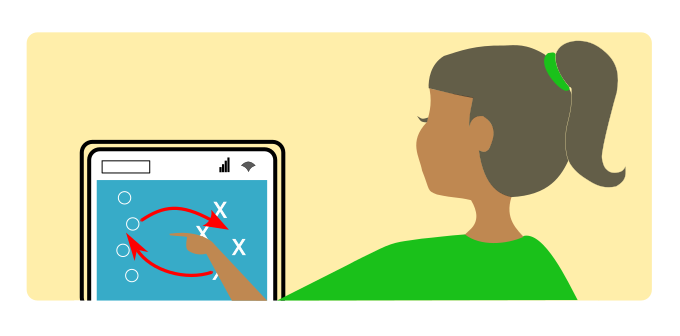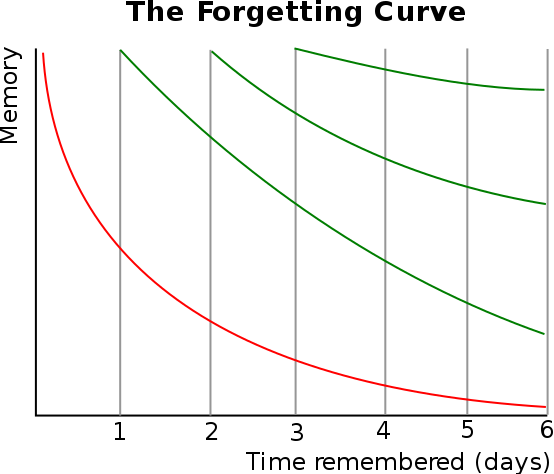AP English & Social Science Tests
Practice as Effective Test Prep Strategy
Updated August 2, 2023

Think about the last time you took a major test. What did you do to prepare? How early did you start? What activities did your study time consist of?
If you’re like most students, you may have studied in ways proven to be ineffective. Some of the most common activities students engage in when preparing for a test have minimal positive impact on test scores. Did you spend most of your time doing any of the following?
- Reviewing your notes
- Rereading instructional materials
- Highlighting, underlining, or making new notes
Each of the above are tempting study strategies. Most of us have been practicing them our entire student careers, and a trusted teacher or parent may have recommended them to us. Even doing them feels right, and we may have performed pretty well on tests where we used these methods to prepare. Reviewing and rereading are alluringly easy to do and give the impression that we are making progress. However, research shows that this feeling is familiarity masquerading as mastery.
The problem with these strategies is that they don’t lead to durable learning. Their effects fade quickly, and if we try to remember something we studied in this way even just a few days later, we usually can’t. That’s because actual learning—the kind that allows us to recall information and apply skills in context—is the product of a much more laborious process that involves repeated trial and error.
Learning through trial and error is especially important when preparing for tests. Tests ask us to recall information, apply knowledge, and perform skills in particular ways. On their own, none of the methods above will help us be successful on test day because they don’t require us to practice any of the challenges tests present.
What will prepare us for test day is practice with authentic test questions, which is why you should spend most of your test preparation time focused on practicing.
Why Practice
Learning science research confirms that practice tests and practice questions boost performance on standardized tests. Numerous studies have examined students randomly assigned to either a test group that is given a practice test ahead of an exam or a control group that is not. The results consistently show that those given the practice test perform better on the exam than those who did not receive a practice test. This finding is commonly known as the Testing Effect.
The argument that practice tests and practice questions are critical for test preparation is also supported by what’s known as the Situated Learning Theory. Have you ever heard the phrase, “practice like you play, and you’ll play like you practice?” That encapsulates this theory, which argues that to perform a task with proficiency, we need to practice that task in a similar context and under comparable conditions to the ones we’ll encounter in the real world. When prepping for a test, test day is like game day, and we need to run the same plays we’ll use on game day during our practice sessions.

Practice is also critical because it strengthens the knowledge and skills that standardized tests assess. While reading, watching, or listening to instruction can introduce us to new topics and help us better understand concepts, it’s only a starting point.
That’s because instruction can only fill knowledge gaps, and it does not ensure that we’ll be able to recognize, recall, or apply that knowledge on test day.
Moreover, instruction cannot close skill gaps, and we know that standardized tests frequently focus their questions on applying skills like solving math problems or analyzing a passage.
Enhanced Prep's expert math tutors can help you take your knowledge application to the next level.
Types of Practice
Now that you understand the starring role practice should play in your test preparation, let’s talk about two very different but equally important types of practice.
- Low-stakes practice
- Simulated practice
Low-stakes practice
Students should spend the majority of their test preparation on what we call “low-stakes” practice. This type of practice has you perform the same tasks you will need to do on the test but is not true to the test environment. It’s like prepping for a marathon by first running a few 5Ks. Low-stakes practice can be done in shorter sessions that are spaced out over days and weeks and can use any level of support you need, including referencing study materials or working with a tutor to solve questions together.
While low-stakes practice sessions should mostly focus on answering authentic questions, study tools like flashcards can be helpful if you need to memorize a lot of information for the test.
Repeatedly attempting to recall basic facts like dates, definitions, and formulas is a much more effective way to memorize that information than simply reviewing it in your notes.
This effortful testing of your memory is known as retrieval practice and will make you more likely to recognize and recall the information you need on test day.
Aside from selective use of flashcards for rote memorization, your low-stakes practice sessions should focus on answering authentic test questions. Sometimes these questions will ask you to simply recall or recognize information you’ve memorized. Most of the time, however, they will require you to apply knowledge and skills in a variety of contexts.
One critical mistake students make is not carefully targeting their low-stakes practice. They practice everything they think they could ever need to know for the test, or they practice in a haphazard way that is both ineffective and inefficient. We advise focusing your practice on the areas that will provide the best return on investment of your time and effort. The best way to determine that return on investment is to consider the following:
- Relative Distribution: How likely is the topic or skill to appear on the test?
- Relative Weight: When the topic or skill does appear, how much is it worth?
- Relative Effort: What are your current strengths and weaknesses?
A diagnostic test can help you determine which test areas you are already good at and which ones you may need to work on. You’ll want to self-reflect on exactly why you are getting certain questions incorrect. Be sure to consider which topics and skills you are struggling with as well as if there are certain types of questions you consistently miss. A tutor can help you with this last part and advise you on the best way to target your practice to address your specific needs and help you reach your target score.
Simulated Practice
Once you’ve improved in your key areas of weakness and are feeling confident in your abilities, it’s time to do a “test run” with a simulation of the actual test. This is like finishing your marathon prep with a 20-mile run in an environment with the same terrain, humidity, and temperature you’ll encounter on race day. A full practice test will help you get a better feel for the sequence and distribution of questions on the test. Be sure to time yourself to ensure that you have the speed and stamina to answer enough questions correctly to achieve your target score within the time limit of the test. A simulation of the actual exam will also give you the opportunity to practice test-taking strategies to maximize your score, including how to prioritize and pace answering questions. A tutor can help you develop a test strategy that is customized to the rules of your specific test and target score as well as your individual strengths and weaknesses.
Practicing Effectively
While focusing your study time on practice is critical, practicing effectively is equally important for success on standardized tests. Part of practicing effectively is targeting your practice as discussed above, but there are other ways you can make sure you are getting the most out of your practice sessions.
Learning science research provides us with multiple clues for how to practice most effectively.
One of the key insights is that practice shouldn’t be too easy.
That’s because practice that feels effortless doesn’t lead to durable knowledge and skills that you’ll be able to use on test day. Instead, practice should involve what is known as “desirable difficulty.”
Variation & Interleaving

One way to introduce desirable difficulty into your practice sessions is by varying and interleaving questions on related topics. When you focus on one concept or skill at a time—usually referred to as blocked or massed practice—you may see large and quick improvements. However, these gains are short-lived, and your skills will likely have evaporated by the time you need them on test day. That’s because drilling on the same question type keeps knowledge and processes at the forefront of our working memory (also known as short-term memory) rather than requiring us to effortfully remember them after some forgetting has set in. This forgetting, followed by successful but effortful remembering, is required for our brains to encode information and skills into our long-term memory where they can be utilized at a later date.
To build knowledge and skills that are durable, vary and interleave your practice. Varied practice involves working on a topic or skill that requires a slightly different approach depending on variations in circumstance. For example, if you are trying to find the value of a triangle’s hypotenuse using the Pythagorean Theorem, varied practice would provide questions that change whether the unknown variable is a, b, or c.
Similarly, interleaved practice alternates between questions testing closely related topics or skills. This might look like a practice session that switches between questions asking you to find the volume of cubes, cones, and cylinders.
Varied and interleaved practice helps you prepare for test day by presenting questions in the same way the test will: all mixed up and with infinite variations that you need to be ready to solve.
Spaced Practice
Another way to make your test preparation more effective is to space out your study sessions over a longer period of time. You’ve likely already been told that you shouldn’t cram for an exam. What you may not know is that learning science research has backed up this advice by consistently showing the positive relationship between better test performance and studying across multiple, shorter sessions.
Have you ever been frustrated after hours of working on a project only to have a revelation on exactly what you should do after walking away and taking a break? That’s the power of what’s called the Spacing Effect. We are asking our brains to process a lot of information when we study, which contributes to what is known as cognitive load. As we put more information into our brains without taking a break, that “load” gets heavier. Eventually our brain can’t handle any more, and we stop processing new information effectively and efficiently. This is the mental block that occurs when we work on something for too long and need a break before we can make meaningful progress. It’s like trying to push a muscle past the point of failure.
When studying is spaced over time, it avoids asking your brain to process too much information too quickly.
It also gives your brain the break it needs to successfully encode new information into your long-term memory where you’ll be able to access it later. That’s why studying for 30 minutes each day over the course of five days works better than studying for 2.5 hours one day. Be sure to leave enough time before the test to get the benefits of spacing out your studying.
Repetition
Related to spacing your studying over time is making sure that you practice the same topics and skills repeatedly over this period. Students often make the mistake of getting something right once (or even a few times) and never returning to it. The problem with this approach is that the longer we go without doing something the more likely we will not be able to do it successfully or even at all. Unfortunately, the moment of truth is often test day when it’s too late.
Think about the last time you forgot a piece of information you once knew or how to do something that you had done before. When was the last time you’d had to recall that knowledge or do that thing? How well did you ever know that information, or how proficient were you ever at that task? If it was something you once knew really well (like the name of your first-grade teacher), chances are you hadn’t had to recall it in a very long time. On the other hand, if it was something you only learned how to do recently and aren’t very good at yet, you may have attempted to do it just a day or two ago.
The predictable diminishment of knowledge and skills that go unused over time is based on what’s known as the Forgetting Curve, which suggests that your likelihood of remembering something is directly proportional to how recently you used it and how well you knew it in the first place.
If you’re trying to remember something on a test that you only learned a few days before, it may be difficult because you don’t know it well enough yet. Or, if you are trying to solve an equation that you learned how to do years ago and haven’t practiced since, your knowledge and skills related to it have “decayed” and may fail you on the test.

So, what’s the remedy to forgetting? Repetition. Spaced repetition resurfaces topics and skills after enough time has passed that some forgetting has begun but not after so much time that we can’t recall the information or do the thing with some effort. You should practice this effortful retrieval when studying for a test by making sure that you return to topics and skills (even those you are already good at) periodically. The better you know the topic or skill, the longer you can go without revisiting it, but don’t go too long.
Getting Guidance
Just because practice should be difficult doesn’t mean that you shouldn’t get help when you need it. In fact, it’s better to rely on supports to help you progress and get better when you struggle than to practice what is easy without supports.
Depending on your situation, each of the following types of support can be critical.
- Feedback on practice
- Additional instruction
- Personalized tutoring
The first line of support during practice should be the feedback you get after you answer a question or take a practice test. You should look at the feedback whether you got a question right or wrong. If you got the question right, make sure you know how and why you got it right. If you guessed, read the explanation to learn what you’ll need to answer the question correctly next time. Use that new knowledge to practice similar questions. If you got the question wrong, read the answer explanation and then interrogate why. Did you not know a piece of information that you needed to remember? Did you forget the steps to solve the problem? Did you get tricked by the question or one of the alternative answer options? Take the necessary steps to address the issue and make sure you can get similar questions correct in the future.
If the explanations for individual questions are not enough to help you understand how to answer similar questions correctly next time, you may need additional instruction. Strategically consult notes or lessons on the test topics and skills to fill any significant knowledge gaps you may have. Just remember that instruction won’t help you remember or apply the knowledge and skills required on the test, so you’ll still need to practice any new things you learn.
If you need more support than test prep materials alone can provide, consider consulting a tutor in either a group or one-on-one setting. They can help you understand challenging topics, successfully work practice questions, and hone your test strategy. Tutors are also excellent resources for knowledge about the test itself and the best ways to study.
Looking for extra support to help you prepare for the SAT? Enhanced Prep has all of your SAT Tutoring needs covered
When to Stop Practicing
After you are consistently getting your desired score on practice tests, you can scale back practice. If there is still a bit of time before test day, you’ll just want to be sure to maintain your knowledge and skills with occasional practice sessions that vary, interleave, space, and repeat. On the day before the test, the best thing you can do is relax, eat well, and get a good night’s sleep knowing that you already put in all the hard work. Good luck!
Ashley Bruckbauer, PhD is the Lead Learning Designer for Study.com, an education technology company dedicated to making education accessible for millions of learners. In this role, she combines learning science research and instructional design best practices to help create effective, efficient, and enjoyable learning experiences that improve learner outcomes. Before her career in EdTech, Dr. Bruckbauer spent over a decade working as an educator and researcher at various museums and universities. She holds a PhD in art history from the University of North Carolina at Chapel Hill, and her scholarship has appeared in publications by Routledge, Bloomsbury, and Smarthistory.
